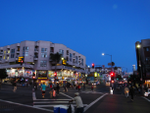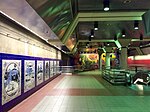South Bonnie Brae Tract Historic District
Historic districts in Los AngelesHistoric districts on the National Register of Historic Places in CaliforniaLos Angeles County, California Registered Historic Place stubsLos Angeles Historic-Cultural MonumentsLos Angeles geography stubs ... and 4 more
NRHP infobox with nocatNational Register of Historic Places in Los AngelesPico-Union, Los AngelesVictorian architecture in California

The South Bonnie Brae Tract Historic District is a historic district of Victorian houses in Los Angeles, California, along the 1000 block of South Bonnie Brae Street and the 1800 block of West 11th Street in the Pico Union section of the city. The homes in the district date to the 1890s and reflect Queen Anne and Colonial Revival architecture. Based on its well-preserved period architecture, the district was added to the National Register of Historic Places in 1988. The listing included 15 contributing buildings on 3.2 acres (1.3 ha).The Athletic Model Guild was located in the district at the intersection of 11th and Bonnie Brae Streets.
Excerpt from the Wikipedia article South Bonnie Brae Tract Historic District (License: CC BY-SA 3.0, Authors, Images).South Bonnie Brae Tract Historic District
South Burlington Avenue, Los Angeles Pico-Union
Geographical coordinates (GPS) Address Nearby Places Show on map
Geographical coordinates (GPS)
| Latitude | Longitude |
|---|---|
| N 34.05 ° | E -118.2775 ° |
Address
7-Eleven
South Burlington Avenue
90006 Los Angeles, Pico-Union
California, United States
Open on Google Maps









